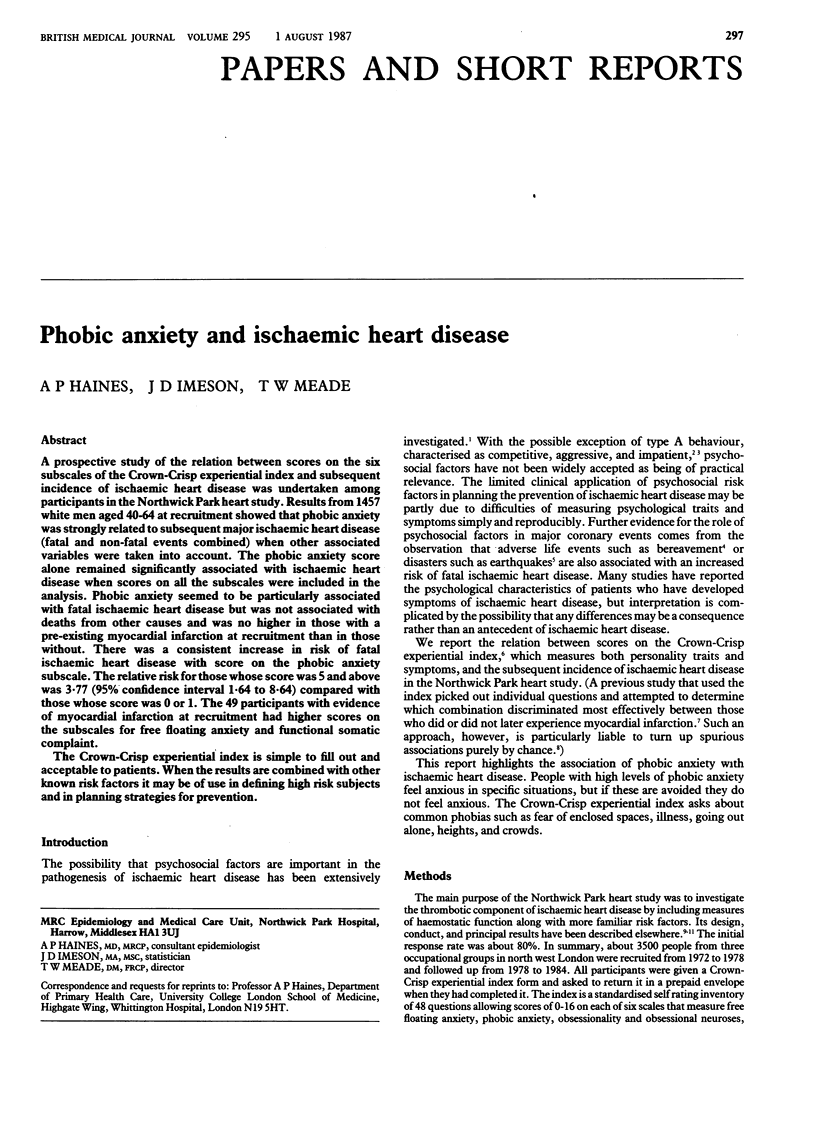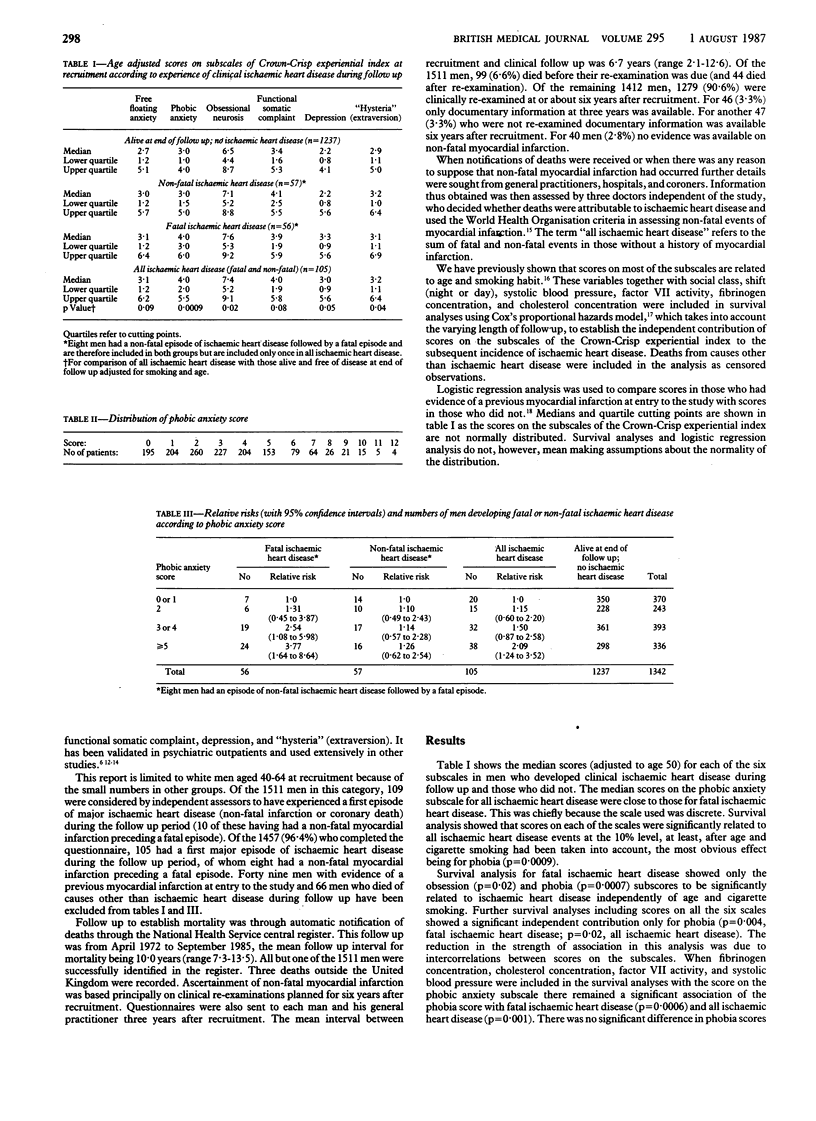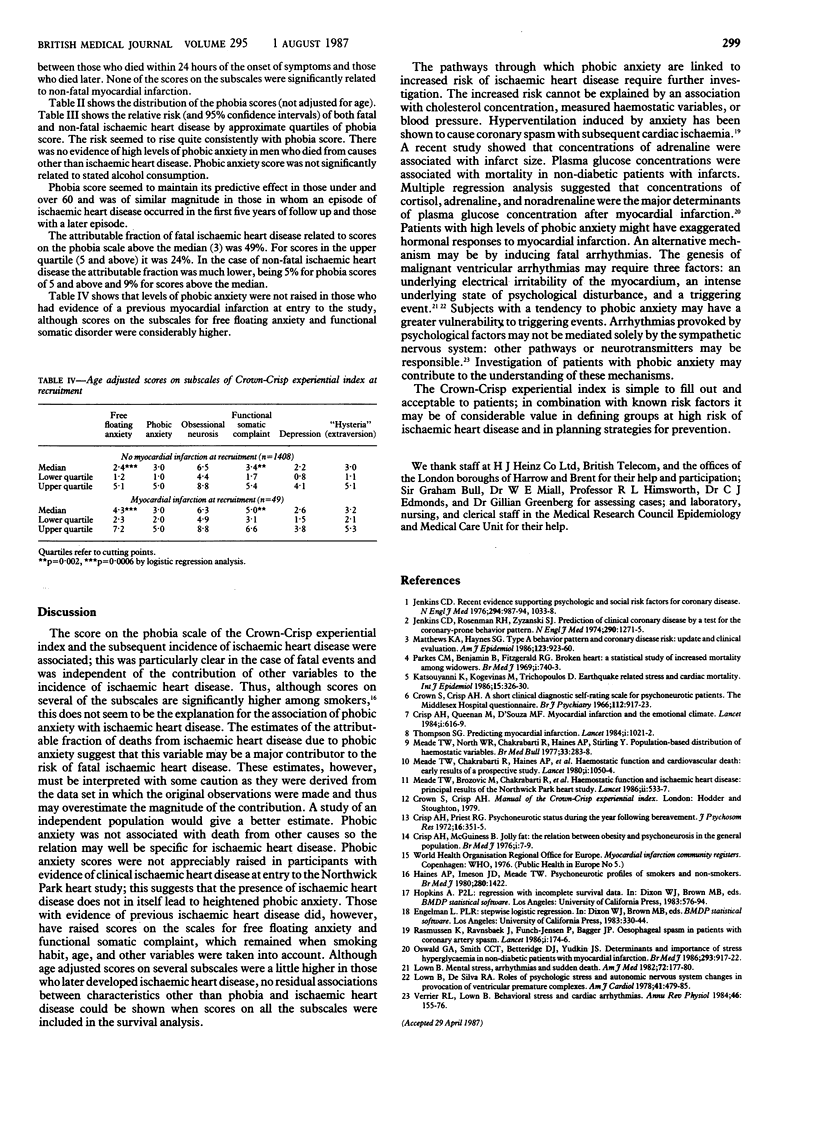Abstract
A prospective study of the relation between scores on the six subscales of the Crown-Crisp experiential index and subsequent incidence of ischaemic heart disease was undertaken among participants in the Northwick Park heart study. Results from 1457 white men aged 40-64 at recruitment showed that phobic anxiety was strongly related to subsequent major ischaemic heart disease (fatal and non-fatal events combined) when other associated variables were taken into account. The phobic anxiety score alone remained significantly associated with ischaemic heart disease when scores on all the subscales were included in the analysis. Phobic anxiety seemed to be particularly associated with fatal ischaemic heart disease but was not associated with deaths from other causes and was no higher in those with a pre-existing myocardial infarction at recruitment than in those without. There was a consistent increase in risk of fatal ischaemic heart disease with score on the phobic anxiety subscale. The relative risk for those whose score was 5 and above was 3.77 (95% confidence interval 1.64 to 8.64) compared with those whose score was 0 or 1. The 49 participants with evidence of myocardial infarction at recruitment had higher scores on the subscales for free floating anxiety and functional somatic complaint. The Crown-Crisp experiential index is simple to fill out and acceptable to patients. When the results are combined with other known risk factors it may be of use in defining high risk subjects and in planning strategies for prevention.
Full text
PDF


Selected References
These references are in PubMed. This may not be the complete list of references from this article.
- Crisp A. H., McGuiness B. Jolly fat: relation between obesity and psychoneurosis in general population. Br Med J. 1976 Jan 3;1(6000):7–9. doi: 10.1136/bmj.1.6000.7. [DOI] [PMC free article] [PubMed] [Google Scholar]
- Crisp A. H., Priest R. G. Psychoneurotic status during the year following bereavement. J Psychosom Res. 1972 Aug;16(5):351–355. doi: 10.1016/0022-3999(72)90088-8. [DOI] [PubMed] [Google Scholar]
- Crisp A. H., Queenan M., D'Souza M. F. Myocardial infarction and the emotional climate. Lancet. 1984 Mar 17;1(8377):616–619. doi: 10.1016/s0140-6736(84)91008-0. [DOI] [PubMed] [Google Scholar]
- Crown S., Crisp A. H. A short clinical diagnostic self-rating scale for psychoneurotic patients. The Middlesex Hospital Questionnaire (M.H.Q.). Br J Psychiatry. 1966 Sep;112(490):917–923. doi: 10.1192/bjp.112.490.917. [DOI] [PubMed] [Google Scholar]
- Haines A. P., Imeson J. D., Meade T. W. Psychoneurotic profiles of smokers and non-smokers. Br Med J. 1980 Jun 14;280(6229):1422–1422. doi: 10.1136/bmj.280.6229.1422. [DOI] [PMC free article] [PubMed] [Google Scholar]
- Jenkins C. D. Medical progress. Recent evidence supporting psychologic and social risk factors for coronary disease (first of two parts). N Engl J Med. 1976 Apr 29;294(18):987–994. doi: 10.1056/NEJM197604292941806. [DOI] [PubMed] [Google Scholar]
- Jenkins C. D., Rosenman R. H., Zyzanski S. J. Prediction of clinical coronary heart disease by a test for the coronary-prone behavior pattern. N Engl J Med. 1974 Jun 6;290(23):1271–1275. doi: 10.1056/NEJM197406062902301. [DOI] [PubMed] [Google Scholar]
- Katsouyanni K., Kogevinas M., Trichopoulos D. Earthquake-related stress and cardiac mortality. Int J Epidemiol. 1986 Sep;15(3):326–330. doi: 10.1093/ije/15.3.326. [DOI] [PubMed] [Google Scholar]
- Lown B. Mental stress, arrhythmias and sudden death. Am J Med. 1982 Feb;72(2):177–180. doi: 10.1016/0002-9343(82)90806-3. [DOI] [PubMed] [Google Scholar]
- Matthews K. A., Haynes S. G. Type A behavior pattern and coronary disease risk. Update and critical evaluation. Am J Epidemiol. 1986 Jun;123(6):923–960. doi: 10.1093/oxfordjournals.aje.a114347. [DOI] [PubMed] [Google Scholar]
- Meade T. W., Mellows S., Brozovic M., Miller G. J., Chakrabarti R. R., North W. R., Haines A. P., Stirling Y., Imeson J. D., Thompson S. G. Haemostatic function and ischaemic heart disease: principal results of the Northwick Park Heart Study. Lancet. 1986 Sep 6;2(8506):533–537. doi: 10.1016/s0140-6736(86)90111-x. [DOI] [PubMed] [Google Scholar]
- Meade T. W., North W. R., Chakrabarti R., Haines A. P., Stirling Y. Population-based distributions of haemostatic variables. Br Med Bull. 1977 Sep;33(3):283–288. doi: 10.1093/oxfordjournals.bmb.a071448. [DOI] [PubMed] [Google Scholar]
- Meade T. W., North W. R., Chakrabarti R., Stirling Y., Haines A. P., Thompson S. G., Brozovié M. Haemostatic function and cardiovascular death: early results of a prospective study. Lancet. 1980 May 17;1(8177):1050–1054. doi: 10.1016/s0140-6736(80)91498-1. [DOI] [PubMed] [Google Scholar]
- Oswald G. A., Smith C. C., Betteridge D. J., Yudkin J. S. Determinants and importance of stress hyperglycaemia in non-diabetic patients with myocardial infarction. Br Med J (Clin Res Ed) 1986 Oct 11;293(6552):917–922. doi: 10.1136/bmj.293.6552.917. [DOI] [PMC free article] [PubMed] [Google Scholar]
- Parkes C. M., Benjamin B., Fitzgerald R. G. Broken heart: a statistical study of increased mortality among widowers. Br Med J. 1969 Mar 22;1(5646):740–743. doi: 10.1136/bmj.1.5646.740. [DOI] [PMC free article] [PubMed] [Google Scholar]
- Rasmussen K., Ravnsbaek J., Funch-Jensen P., Bagger J. P. Oesophageal spasm in patients with coronary artery spasm. Lancet. 1986 Jan 25;1(8474):174–176. doi: 10.1016/s0140-6736(86)90651-3. [DOI] [PubMed] [Google Scholar]
- Thompson S. G. Predicting myocardial infarction. Lancet. 1984 May 5;1(8384):1021–1022. doi: 10.1016/s0140-6736(84)92365-1. [DOI] [PubMed] [Google Scholar]


